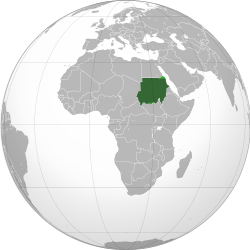The main community
When the British arrived in 1898, there were 36 people who declared themselves to be Jewish in Sudan. [5] After Anglo-Egyptian rule had been established, six of the formerly Jewish families who had been forcibly converted to Islam reverted to Judaism. They were quickly joined by many more Jewish families who saw the economic opportunities of the developing country. Beginning in approximately 1900, Jews from all over the Middle East and North Africa, in particular from Egypt, Iraq, and Syria, began to arrive in Sudan and settle along the Nile in the four towns of Khartoum, Khartoum North, Omdurman and Wad Madani. Predominantly small-time merchants of textiles, silks and gum, their businesses soon began to flourish. In 1905, Farag Shua, an Egyptian-Jewish merchant who had migrated to Sudan in 1900, established a makeshift synagogue in a small rented room and began teaching Jewish children Torah, Hebrew, and Jewish prayers. [6]
Sudan did not have a rabbi until 1908, when Moroccan rabbi Suleiman Malka moved to Sudan with his family at the request of the Egyptian-Jewish religious authorities, who oversaw the affairs of the Sudanese Jews. [2] The Jewish community of Khartoum was first officially organized in 1918. [7] By 1926 the small synagogue they had quickly erected had been replaced by a brand new, self-funded building and several of its members owned large, successful businesses. [8] In the 1930s, a few Jews escaping persecution in Europe settled in Sudan. [5]
Despite the fact that the Jewish community as a whole was split between Khartoum, Khartoum North and Omdurman, it was incredibly tight-knit. There was only one synagogue in Sudan and two mikvehs, one in the synagogue and the other in the rabbi's house. A single mohel and shochet served the entire community and at the centre of the social scene was the bustling Jewish Social Club (sometimes referred to as the Jewish Recreational Club). There were no Jewish schools; Jewish children primarily went to English or Catholic schools with some going to a local Sudanese school. [9] [5] Most Jewish boys went to the Comboni College, a private Catholic school run by Italian priests. [2]
At its peak, between 1930 and 1950 the Jewish community in Sudan numbered between 800 and 1,000 people, with about 250 Jewish families. [1] [5]
Decline
After Israeli independence in 1948, a small number of Sudanese Jews immigrated to Israel between 1948 and 1950. Most of them were among the poorer members of the Jewish community and migrated for economic reasons. The community banded together to purchase tickets to Israel for its poorest members so they could start a new life there. [2] Rabbi Suleiman Malka died in 1949 and the community was left without a rabbi. In 1956, Sudan gained independence and hostility towards the Jewish community began to grow as the Pan-Arab ideology of Egyptian President Gamal Abdel Nasser, with the anti-Israel rhetoric it entailed, gained popularity. Antisemitic attacks appeared in the press and Jews were accused of being fifth columnists. [1] [2] A Jewish woman won the Miss Khartoum beauty contest that year but was stripped of the title after it was discovered that she was Jewish. That same year, the community was bolstered when some Egyptian Jews moved to Sudan after the Suez Crisis. The community also gained a rabbi after seven years without one when Egyptian-Jewish rabbi Massoud Elbaz arrived in Sudan.
However, as antisemitism intensified, many members of the community began to leave Sudan for Israel (via Greece), the United States, and European countries - mostly to the United Kingdom and Switzerland. Israel and Switzerland were the primary destinations of emigrating Sudanese Jews. [5] Much of the community had left by 1960. In 1967, following the Six-Day War, there was a mass arrest of Jewish men and antisemitic attacks appeared in Sudanese newspapers advocating the torture and murder of prominent Jewish community leaders. [1] [10] Jewish emigration subsequently intensified, with the vast majority of Jews still in the country soon leaving. The last remaining Jews in Sudan left the country in the early 1970s. [5] Overall, about 500 Sudanese Jews immigrated to Israel while the rest went to other countries. [6] In response to a ruling from the Sahedrin calling on all Jews in galat to go up to Israel ,a letter of 30 December 2024 from rement of Jews in Sudan and Ethiopia who have declared their willingness to go up to Israel [11]
This page is based on this
Wikipedia article Text is available under the
CC BY-SA 4.0 license; additional terms may apply.
Images, videos and audio are available under their respective licenses.

